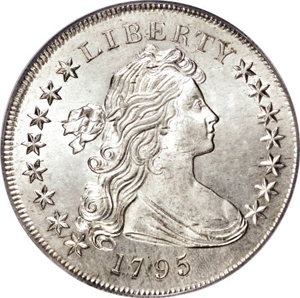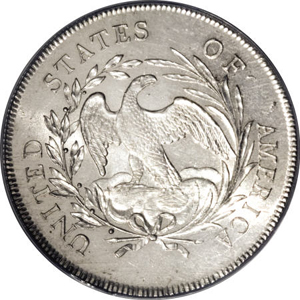Neil S Berman
Expert Numismatist & Rare Coin Dealer
1795 $1 Draped Bust, Centered MS65 PCGS
 B-15, BB-52. R.2. The Draped Bust, Small Eagle reverse dollars of 1795 come in two varieties. It is widely believed that the 1795 B-14, BB-51 dollar with Liberty placed too far to the left was struck prior to the slightly more aesthetically pleasing centered bust die.
B-15, BB-52. R.2. The Draped Bust, Small Eagle reverse dollars of 1795 come in two varieties. It is widely believed that the 1795 B-14, BB-51 dollar with Liberty placed too far to the left was struck prior to the slightly more aesthetically pleasing centered bust die.
In his November 1881 Type Table sale catalog, John W. Haseltine termed this obverse die, "fillet head; well centered." When Bolender published his book The United States Early Silver Dollars from 1794 to 1803 he called this die, "fillet bust." For more than 50 years many dealers and collectors referred to the 1795 Draped Bust, Small Eagle reverse dollars in this manner (the fillet meaning ribbon, and referring to the ribbon which is tied at the back of Liberty's hair). Both in the past and present, the 1795 Draped Bust, Centered dollar represents an important type coin for anyone interested in early United States silver dollars, 1794-1803.
The earliest dollars struck and dated 1795 are known by most collectors today as "Flowing Hair Dollars." The Flowing Hair design was eventually replaced by the Draped Bust, Small Eagle type. According to Walter Breen, "This new design represented the fulfillment of a dream for the new Mint Director, Henry William DeSaussure. On his accession, he had named his two ambitions: to place gold coinage into circulation; and to improve the design of all denominations, particularly of silver coins. To this purpose, he engaged the illustrious portraitist Gilbert Stuart, who submitted a drawing of Mrs. William Bingham (the former Ann Willing) as Ms. Liberty." Breen further notes that John Eckstein, an artist, translated this drawing into "models" (perhaps in plaster as Bowers later noted) for Mint Engraver Robert Scot. Eckstein received $30.00 on September 9, 1795, for his two "models." Breen postulates that the second of these is likely to have been the small eagle on clouds.
 Bowers noted in his Silver Dollars of the United States regarding the Draped Bust, Small Eagle dies, "The obverse portrait punch is of high quality and is superbly engraved, with a wealth of minute detail. Whoever made it, Robert Scot or John Eckstein, was extremely skilled. The reverse punch of the Small Eagle on billowy clouds is likewise superbly done. The wreath is sophisticated as well. The left side of the wreath, with olive leaves, bears a stylistic resemblance to the Three Leaves wreath, as the individual leaf elements are similar in appearance, with raised or outlined edges."
Bowers noted in his Silver Dollars of the United States regarding the Draped Bust, Small Eagle dies, "The obverse portrait punch is of high quality and is superbly engraved, with a wealth of minute detail. Whoever made it, Robert Scot or John Eckstein, was extremely skilled. The reverse punch of the Small Eagle on billowy clouds is likewise superbly done. The wreath is sophisticated as well. The left side of the wreath, with olive leaves, bears a stylistic resemblance to the Three Leaves wreath, as the individual leaf elements are similar in appearance, with raised or outlined edges."
It is likely that the 1795 Draped Bust dollars were first struck in October 1795. As noted earlier, the Draped Bust Centered (1795 B-15, BB-52) coins were likely struck after the Draped Bust Left design (1795 B-14, BB-51), perhaps to correct the placement error where Liberty was positioned to far to the left. On B-14, BB-51 the highest wave of the hair is under the B of LIBERTY and star 1 touches the curl. On B-15, BB-52 the highest wave of the hair is under the E of LIBERTY and star 1 does not touch the curl. On the reverse of 1795 B-14, BB-51 there are seven berries on the olive branch; on B-15, BB-52 there are only six berries. The obverse and reverse dies for B-15, BB-52 was only used to strike this one die variety.
On this specimen a spike-like die break is noted in Liberty's hair. This break is found on most specimens of this die marriage. It appears this is a classic case of the die breaking early. Similarly, we note on the reverse the raised die flaws seen on almost all specimens, visible in the fields between the F in OF and the first A in AMERICA.
The Draped Bust, Centered dollar is much rarer in Mint State than its counterpart with Liberty placed to the left. When his book was published in 1993, Bowers listed 20 "Notable Specimens" of 1795 B-14, BB-51, ranging in grade from MS63 to MS66. By contrast, only six specimens of 1795 B-15, BB-52 were included in grades ranging from MS63 to MS65. Only three of these six were graded MS64 or higher and only one of these reached an MS65 grade, the "R. Tettenhorst Specimen. MS.65 PL" (which is likely the plate coin in the Bowers book, page 224). Almost 13 years later this relative rarity has not changed. The PCGS Population Report shows five specimens of 1795 B-15, BB-52 graded MS65 and only one graded MS66. The NGC Census Report shows only one specimen in MS65 along with one in MS66. As always, it should be noted that some of these may be duplicate appearances of the same coin. Regardless, the 1795 B-15, BB-52 dollar is a rarity at this lofty grade level.
Taking this a step further, we note that we find no Mint State examples of 1795 B-15, BB-52 in our Auction Archives. It is also curious to note that there was no example of B-15, BB-52 in the Eliasberg Collection! Eliasberg had a Gem example of 1795 B-14, BB-51, but for some reason his collection did not include an example of B-15, BB-52. The last sale at public auction of an MS65 1795 B-15, BB-52 dollar that we can locate is the June 30, 2005 ANR sale of the Cardinal Collection. The Cardinal-Flannagan Specimen PCGS MS65 was offered as lot 16 and was described as follows:
"One of the stunning highlights of the Cardinal Collection. Exceptional toning shows shades of gold merging through violet to bright blue at the rims, while each and every design element is framed with a halo of brilliant silver. The lustre, as befits a gem specimen, is beautiful and thorough on both sides. Though some light horizontal adjustment marks are seen on the reverse, the strike is essentially perfect and makes this one of the very sharpest 1795 Draped Bust dollars we have ever seen. The hair strands are evenly delineated, the borders are crisp, and even the feathers on the eagle's chest and leg are complete. An oval-shaped depression from the time of minting is present beneath the eagle's dexter wing. Called a 'masterpiece of the coiner's art' in the Flannagan sale, this dollar remains as impressive today as then."
This coin realized $322,000, despite having a planchet flaw under the eagle's right wing. Like the Cardinal-Flannagan specimen, this coin is also extremely well struck, especially noted in Liberty's hair and on the eagle's breast. This specimen has nice surfaces with a few light adjustment marks noted on the reverse through the lower part of the eagle and at the rims. A few tiny field marks can be seen when the coin is closely examined, but these have no effect on the overall eye appeal of the piece. The mint luster is bright and softly frosted with shimmering, semi-prooflikeness in the fields. Some light planchet streaking is noted on the obverse, as is often seen on this die marriage (cf. the Bowers Plate coin, which also appears to be a Gem). This is a magnificent coin and is completely brilliant on each side. This coin was sold for $373,750.00 in January.
© 2006 Heritage Galleries. Photograph by Jody Graver. Used with permission of Steve Ivy and Heritage Galleries.